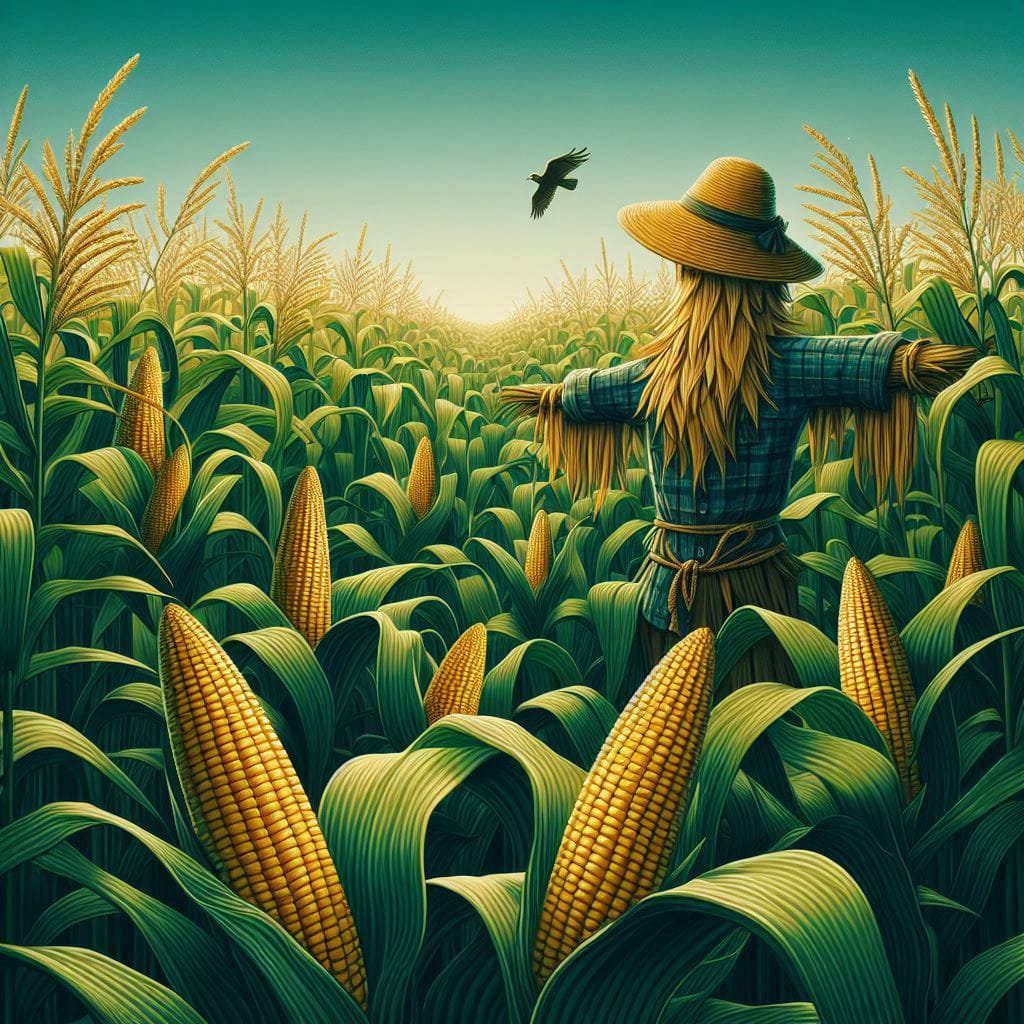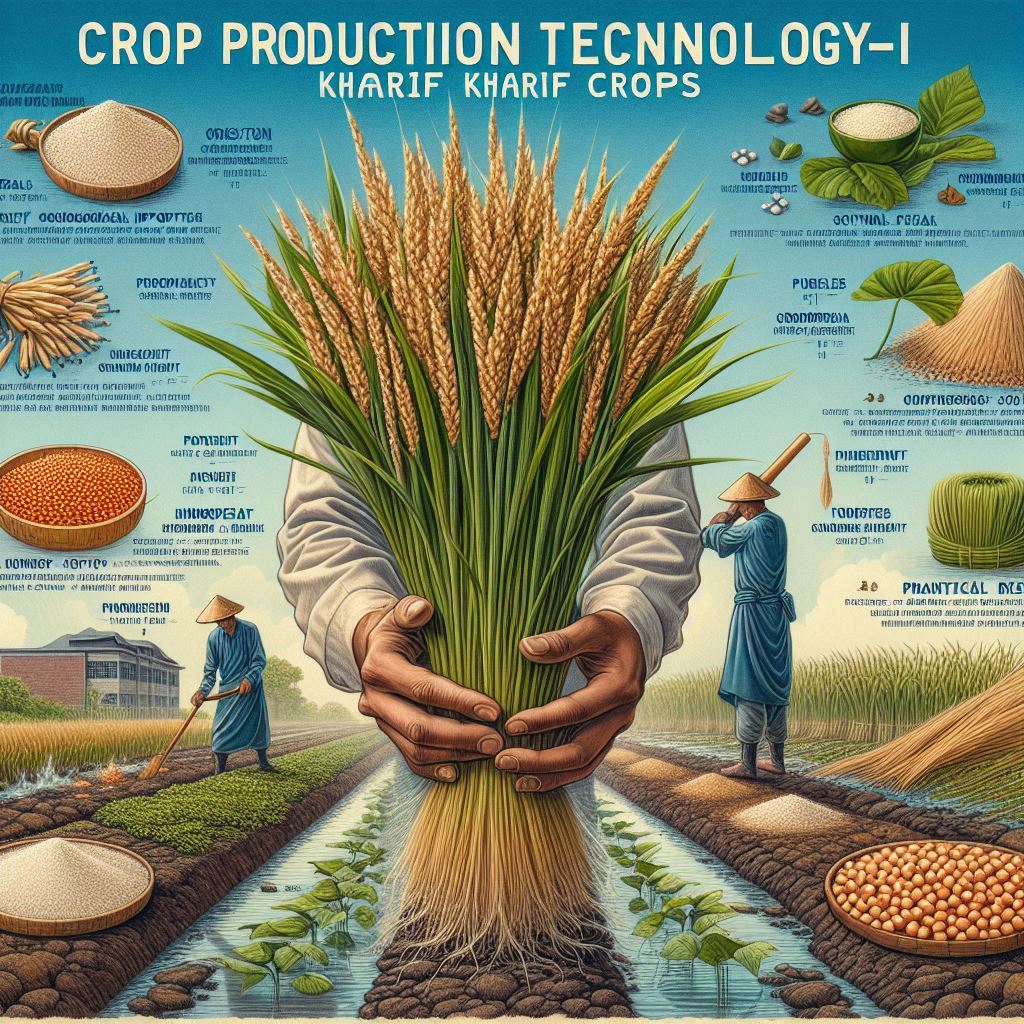AGRON – 211 Crop Production Technology – I (Kharif Crops)
Pearl Millet (Pennisetum glaucum L.)
- Major coarse cereal.
- Mostly grown in Africa and Asia.
- Deficient in lysine.
- 11.6% protein (more than maize and sorghum).
- Higher contents of vitamin A, B1, and B2.
- Energy level of 361 kcal (maximum among grain cereals).
- Known as “poor man’s crop/food.”
- AICRP on Pearl millet, Jodhpur (Rajasthan), 1995.
Composition:
- Carbohydrates: 67.5%
- Protein: 11.6%
- Fat: 5%
- Fiber: 1.2%
- India is the largest producer of pearl millet.
Origin: Africa
- Out of 32 total species, only two are out of African continent: Pennisetum glaucum (pearl millet) and P. perpureum (Napier grass).
- Pearl millet is originated from its wild progenitor of Pennisetum ssp. violaceum.
- Unlike sorghum, pearl millet does not resist drought/water stress condition. However, in such condition, its life cycle shortens and comes to flowering. This mechanism is known as drought escaping mechanism.
Family: Gramineae (Poaceae)
Taxonomy:
- P glaucum (pearl millet): 2n-14 (diploid)
- P purpureum: 2n-28 (allotetraploid)
- Short day plant, cross-pollinated.
- Rachis is cylindrical, not zig-zag as in wheat.
- Grain is caryopsis, oval-shaped and gynoecium are protogynous.
- Spikelet has two sterile glumes and two florets; lower floret is male while upper is hermaphrodite.
According to Stapf, genus Pennisetum have 5 sections:
- Gymnothria
- Eupennisetum
- Pennicillaria
- Heterostachya
- Brevivalvula
- P. glaucum and P. purpureum (Napier grass) belong to Pennicillaria.
- Napier grass is perennial; cultivated for forage.
- Pusa Giant Napier is a cross between P. glaucum and P. purpureum.
Growth stages:
- First coleorhizae appear outside the pericarp 24 hours after moisture absorbance.
- Adventitious roots emerge from the lower nodes of the leaves.
Varieties of Pearl millet
- 1st pearl millet hybrid was HB 1 (Hybrid Bajra 1) released from Ludhiana in 1965 by crossing Tift 23A x Bil 3B through CMS system of hybridization.
- Other pearl millet hybrids are:
| Released From | Rajasthan (Jaipur) | Haryana (Hisar) | Punjab (Ludhiana) | Delhi (Pusa campus) | Jamnagar | ICRISAT |
|---|---|---|---|---|---|---|
| Hybrids | RHB 30, 58, 90, 121, 154 | HHB 45, 50, 60, 67, 68, Improved, 68, 94, 117, 146, 197, 216, 223 | PHB 10, 14, 47, 2168 | HB-3, 4, 5, BJ 104, CJ 104, BK 560, CM 46, BD 111, BD 763, Pusa 23 (MH 169), 322, 415, 444, 605 | HB 2, 3, GHB 15, 27, 32, 183, 235, 526, 538, 558, 577, 719, 732, 1399 | MH 179 (ICMH 451), MH 180, 143, 312, ICMH 356 |
- ES 1 was the first open pollinated variety of pearl millet released from Hisar in 1978.
Open pollinated varieties (composite)
| Rajasthan | Haryana (Hisar) | Punjab (Ludhiana) | Delhi (Pusa campus) | ICRISAT |
|---|---|---|---|---|
| Jaipur – RCB 2, Raj 171 | ES 1, HC 4, HC 10 | PSB 8, PCB 15, PCB 164 | Pusa Safed, Pusa 266, Pusa Composite 334, 383, 443 | WC 375, ICMS 7703, ICTP 8203, ICMV 155, 221, WCC 75 |
| Jodhpur – CZP 1C 923, CZP 9802 |
Climate
- Pearl millet is crop of warm climate, grown in arid and semi-arid climate of tropical and sub-tropical regions.
- Globally, pearl millet is grown between 15°W to 90°E longitude and 5°S to 40°N latitude.
- Vegetative stage: There must be moist weather, light-medium rainfall.
- Flowering & grain-filling stage: There should be no rainfall, clear and dry weather.
- Rainfall during grain maturity period results in infection of diseases like ergot because of high atmospheric humidity.
- The optimum temperature for vegetative phase – 27-30°C. The temperature below this, increase ergot infection while high-temperature force in early flowering.
Soil
- Loamy sand to the loamy soil is best for pearl millet.
- It is more sensitive to saline soil. However, alkaline soils are not much harmful.
Seed and sowing
- It requires a fine and smooth seed bed as the seeds are too small.
- Furadon @ 5-8 kg/ha is mixed in the soil to control termite.
- The optimum time of sowing is 1st fortnight of July (onset of monsoon).
- In Tamil Nadu, pearl millet is grown as Rabi rainfed crop in regions with north-eastern monsoon from September-December.
- Transplanting is recommended for delayed sowing which can save a time of 3-4 weeks.
For transplanting: 500 m² nursery areas are sufficient to transplant in 1 ha area.
- 3-4 weeks old seedling is planted at the spacing of 50 x 10-12 cm² (1, 75,000-2, 00,000 plants/ha).
- Seed rate – 4-5 kg/ha (3 kg/ha in heavy soil and 4.5 kg/ha in the sandy soil of Rajasthan).
- In case of transplanting, 2 kg seed/ha is sufficient.
- Seed is sown at a row to row spacing of 45 x 15 cm² at 3 cm depth.
Weed management Pearl millet
- The critical period of crop-weed competition is up to 35 DAS.
- Striga sp. (witch weed) is partial root parasite of pearl millet.
- The crop needs 2-3 intercultural operations between 3-6 weeks after sowing.
Chemical weed control
| Herbicide | Dose (a.i. kg/ha) | Applied as | Type of weed to be controlled |
|---|---|---|---|
| Atrazine | 0.5 | Pre-emergence | Broad-leaved weeds |
| Simazine | 1.0-1.5 | Pre-emergence | Wide spectrum weed |
| Pendimethalin | 0.75-1.5 | Pre-emergence | – |
Nutrient management Pearl millet
- The general NPK recommendation of pearl millet is 40-60 kg N, 30-40 kg P₂O₅ and 30-40 kg K₂O/ha.
- 50% of N is applied at sowing and 50% at 3-4 weeks after sowing as top-dressing.
- Entire dose of PK is applied at sowing time as a basal application.
- Application of 80-120 kg N/ha increases protein content 50%, tryptophane and methionine 30-50% but not leucine content.
- Bio-fertilizers viz. Azotobacter and Azospirillum brasilense are used in pearl millet along with a lower dose of N (10-40 kg/ha).
Water management Pearl millet
- Water requirement (WR) of pearl millet is 250-350 mm which is less than sorghum, maize and finger millet (500-600 mm).
- Irrigation at flowering stage or anthesis is beneficial.
- It requires, on an average 140-150 mm of water/tonne of grain produced.
- Reduction in plant density is one of the important mid-way correction techniques followed to save drought hit pearl millet.
Disease management Pearlmilllet
| Disease | Infection | Symptoms | Management |
|---|---|---|---|
| Downy mildew or green ear disease (Sclerospora graminicola) | Transfer by oospores on seed or mycelium of seed embryo | Downy growth on lower leaf surface, wrinkled and split leaves, profuse tillering, ears either not produced or abnormal ear which transferred into twisted leafy structure | Use of hybrid and composite varieties, Seed treatment with Apron 35 D @ 8 g/kg seed. |
Disease Management in Pearlmilllet
Ergot (Claviceps fusiformis)
- Infection: Sclerotia produce ascospores which become air-borne and infect florets. Secondary infection through rain/insect. More infection in high humidity and at 20-25°C temperature.
- Symptoms: Small droplets of pinkish or light honey-like fluid exuding from infected spikelet of ear, which later dried and become hard.
- Management: Use 10% salt solution to remove sclerotia. Use a mixture of ziram @ 2 g/liter (0.1%) + benlate (0.1%).
Smut (Tolyposporium penicillariae)
- Infection: Primary infection through chlamydospores.
- Symptoms: Grains are replaced by powdery material, initially, these are green later become dark black that causes secondary infection.
- Management: Spray Vitavax or Iantavax 0.25% on panicle at booting stage.
Rust (Puccinia penniseti)
- Infection: Alternate host – brinjal.
- Symptoms: Appears on both side of leaves, uredinial & telial stages on pearl millet while spermagoniol & aecial stage on brinjal occurs, orange-colored spores which later turn black.
- Management: Zineb 0.2% or mancozeb 75 WP spray. Remove alternate host.
Insect Management in Pearl millet
Shoot fly (Atherigona approximate)
- Infection: Pest of N. India, attack up to 3-week plant, lays eggs singly on either lower side of leaf or base of plant, cut the apical point results in ‘dead heart,’ cut off panicles.
- Management: Early planting. Two dusting of 5% malathion @ 25 kg/ha at 10 & 20 DAS.
White grub (Holotrachia sp.)
- Infection: Feed on roots of young seedling results in wilting-like appearance, maximum damage in July-August.
- Management: Intercropping with legumes. Seed treatment with chlorpyriphos 20 EC @ 12.5 ml/kg seed. Soil treatment with phorate 10 G 12 kg/ha.
Grain midge (Geromyia penniseti)
- Infection: Attack on developing grains, lays egg in flower, grain-less glumes with white-purple case on the tip of spikelet.
- Management: Spray metacid 250 cc orthiodan 625 cc.
Termite (Odontotermis obesus)
- Infection: Serious in dry areas, feed on roots and lower stem portion.
- Management: Irrigation, Use well-decomposed FYM.
Intercropping
- Paired row planting is preferred in place of uniform row.
- For this, 70 cm spacing between two paired row and 30 cm between two rows of one pair is maintained.
Harvesting
- At harvesting 15-20% moisture in grain is ideal.
- Moisture content for safe storage of grain is 12-14%.
Read More





![[PDF] BSc Agriculture 3rd semester Notes Download](https://eagronomy.com/wp-content/uploads/2024/09/AddText_09-23-09.27.27.jpg)

